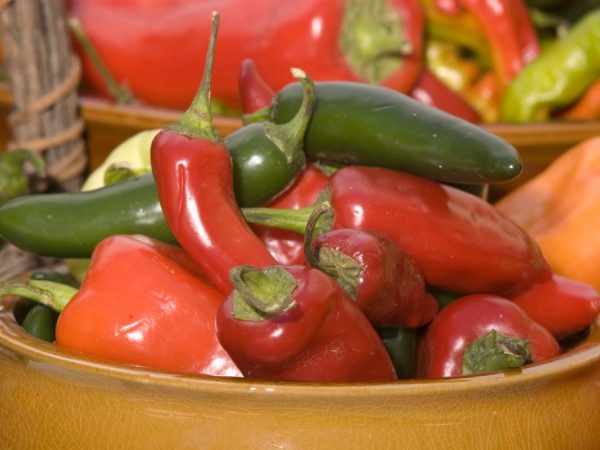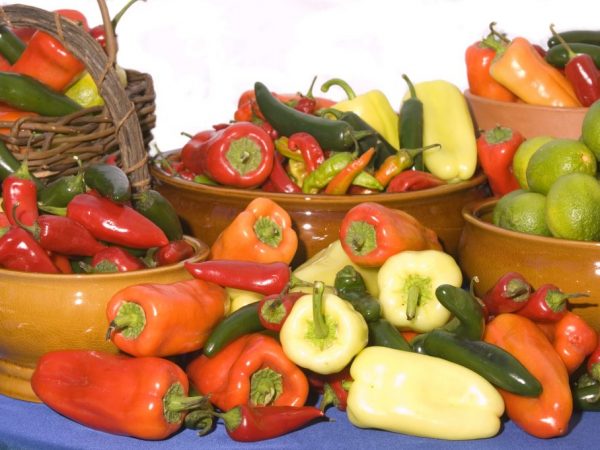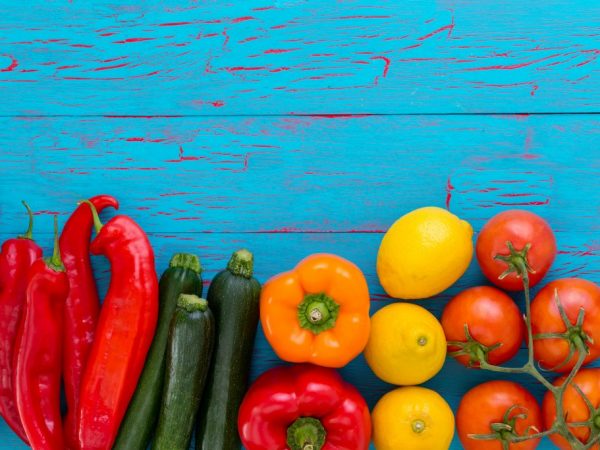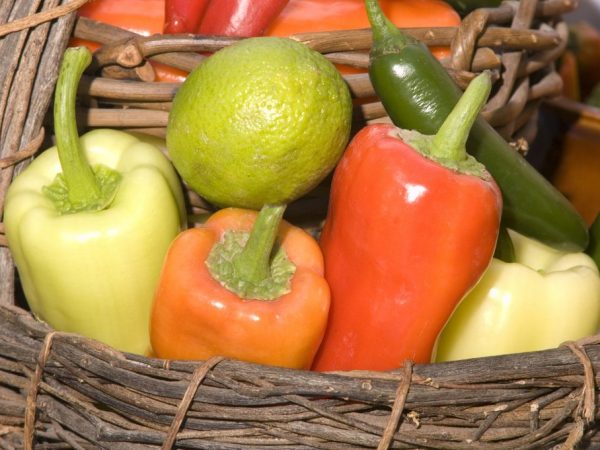Characteristics of Jalapeno salad peppers
Everyone is familiar with chili pepper, which occupies a leading position among the hot types of peppers. But no less interesting and piquant taste has its relative, Jalapeno pepper, which can be easily grown at home and surprise everyone with exquisite Mexican dishes, where it is so often used.

Jalapeno salad peppers
Description of the variety
Jalapeno is a pepper that is a variation of the famous chili pepper. Mexico is considered his homeland, where huge areas of land are allocated for the cultivation of this hot pepper. Named after the city of Xalapa. It is appreciated by culinary experts all over the world for its moderate pungency, which tends to vary depending on the degree of ripeness and the method of preparation. In accordance with the international Scoville scale, this variety of pepper has indicators of pungency in the range of 10-20,000 points, which is an order of magnitude less than that of many types of chili peppers. Roccotillo pepper is less hot than Jalapeno and has 1000-2500 points on a scale, but Cayenne is twice as hot.
Jalapeno has the following features:
- ripening time 65-75 days;
- standard bush, up to 1 m high;
- fruit length 5-10 cm, diameter 2.5-3 cm;
- the average weight of peppers is 50-60g;
- the shape of the pods is even conical;
- at the moment of technical maturity, the Jalapeno pepper is green;
- yield 1-1.5 kg from one bush.
Jalapeno is a pepper that is harvested in a state of technical maturity (green), ripe fruits that have reached a red color are considered to be of low quality and are used only for drying and drying. Jalapeno is a pepper that has a specific sour taste. The pungency in the fruits is unevenly distributed, the tissues of the seed chambers have the maximum bitterness, removing them, their pungency can be reduced.
This bitter Mexican pepper is grown in different parts of the world. It grows quickly and produces crops. In southern countries it is cultivated as a perennial plant, in the middle lane as annuals. They practice growing this hot pepper on the windowsill.
Useful qualities
In addition to the spicy taste and pungency, which can enrich the dish, it has many useful properties. The large amount of pungent enzyme in Jalapeno peppers has the ability to:
- kill pathogens and prolong the freshness of food;
- improve metabolic processes, promote weight loss;
- increase the production of gastric enzymes, which facilitates the digestion of heavy protein foods;
Jalapeno's scope of application:
- In medicines, to speed up metabolic processes and stimulate appetite.
- In cosmetology, Jalapeno is used in masks for hair growth and masks for cellulite.
- In folk recipes, as a remedy for sweating on the feet, this is due to antibacterial properties.
All these properties encourage the cultivation of such a pepper on a personal plot, and its agricultural technology will not differ from that used to grow the usual sweet pepper.An excellent option would be to grow a bush on your own windowsill, at home it can be grown as a perennial plant.
Growing

Good harvest
Growing Jalapeno peppers at home is easy.
You can plant hot Mexican Jalapeno peppers at any time of the year, but it is better to do this in spring, then the young plant will have enough light and warmth, and the biorhythms of the plant will correspond to natural ones. This has a good effect on its development and fruiting.
Soil preparation
The description shows that it is important to select the appropriate planting soil and prepare it before sowing the seeds.
Peppers such as Jalapenos do well in loose, drained, nutritious soils. Ready-made store soil mixture is suitable for growing at home. Universal for flowering plants or specialized for vegetable crops will absolutely meet the requirements. You can also prepare the soil mixture yourself. To do this, you need to mix:
- 5 kg of turf or leaf land;
- 3 kg of lowland peat;
- 2 kg of river sand;
- 5 liters of agroperlite.
The purchased or prepared soil mixture must be disinfected before sowing seeds into it. This can be done thermally or chemically. Thermal consists in spilling the soil with boiling water or calcining in the oven at a temperature of 100-120 ° C. For chemical disinfection, you can use a solution of potassium permanganate or hydrogen peroxide. Potassium permanganate is diluted with a concentration of 1 g per 2 liters of water, peroxide 1 tbsp. l. for 1 liter of water. The soil is spilled with the prepared solution.
Sowing seeds
Seeds must be sown first for seedlings in small containers. These can be plastic containers, cups, peat pots. Before sowing, pepper seeds must be disinfected, and then soaked to swell. Potassium permanganate is used for disinfection. A 1% solution is prepared and the seeds are kept in it for 20-30 minutes. After this procedure, they must be rinsed with clean water. Spread the seeds on a piece of gauze moistened with water or a solution of a growth stimulant, leave for 24-48 hours, making sure that they do not dry out. After such a thorough preparation, the seeds are sown into the soil, sealed to a depth of 1-1.5 cm. The crops are covered with foil. The containers are placed in the brightest and warmest place without drafts. Seedlings appear in 7-10 days.
Seedling care
When friendly shoots appear, they begin to open the film a little, increasing the time that the seedlings are without shelter. After a few days of this hardening, the film is completely removed. Caring for young Jalapeno plants comes down to several rules:
- Regular watering. The soil should not dry out, use warm, settled water, at the initial stage, the seedlings can be watered with a teaspoon.
- Top dressing. It is carried out 10 days after germination. To simplify care, you can use ready-made fertilizers that are suitable for seedlings (Master, Kemira, Gumat).
Already during the period of growing seedlings, you can pinch the top so that the bush begins to branch and does not stretch, this is done when the sprout has 15-20 cm.
Transfer
When 2-3 pairs of true leaves grow on the seedlings, it needs to be transplanted into a pot to a permanent place. Ceramic or plastic with a volume of at least 5 liters is suitable. The ego is filled with a soil mixture, the same as used for sowing the seeds. A deepening is made, spilled with settled water. Seedlings are neat, they will not damage the earthen lump, they are transplanted. The earth around the stem is compacted. After 2-3 days, the transplanted seedlings are watered with a solution of Epin or Kornevin to stimulate root formation and accelerate rooting. The plant will feel comfortable in a bright place with an air temperature of 24-28 ° C, protected from drafts.
Care

Unpretentious pepper
Holopeno is a vegetable variety of pepper that is not picky about care and grows quickly even at home.But compliance with the basic rules in growing will help to get a healthy plant on the windowsill that will delight you with the harvest.
Watering
Adequate watering is the key to the successful cultivation of any plant. Water is essential to support all metabolic processes. With a lack of moisture, plants grow poorly, the process of photosynthesis slows down, nutrients are supplied in insufficient quantities. All this entails irreversible consequences, instead of a lush bush with beautiful hot peppers, a weak plant with single flowers, small fruits and dried leaves grows on the windowsill. In order for the bushes to develop in full force, watering is carried out:
- as the soil dries up;
- separated water at room temperature;
- in evening time;
- at least twice a week.
But waterlogging the soil is also not worth it, excess moisture leads to its stagnation and decay of the root system. To make it easier to navigate, when watering the bush, you can use a wooden skewer, which is inserted into the pot and to check the level of drying, pull it out and check if it is wet. If the skewer is wet only at the bottom, then the plant already needs watering.
Top dressing
Jalapeno is a pepper that requires regular feeding and a sufficient amount of trace elements such as nitrogen, phosphorus and potassium during the period of intensive growth, flowering and ripening of the fruit. Top dressing from the moment of transplantation is applied every 14 days. Mineral and organic fertilizers are used. Pepper reacts well to superphosphate feeding. By introducing it in the form of a solution, 1 g of fertilizer is dissolved in 1 liter of water. Mineral dressings are alternated with organic ones. For Jalapeno, Potassium Humate is ideal; it is introduced in accordance with the instructions, adhering to the recommended dosage. Bushes grow well if they are fed with wood ash. Ash is used in dry form and in the form of a solution. Dry under a bush, close up 0.5 tsp. and watering the soil well. You can also 1 tbsp. l. pour ash 1 liter of water, insist 12-24 hours and water the plants, for one bush 250 ml of such a solution is enough.
Features of care in winter
Since Jalapeno peppers are perennials after harvest, there is a dormant period after a while. The bush slows down or stops growing, and also partially or completely throws off the leaves for 2-3 months. During this period, it is kept at a temperature of 12-18 ° C, watering is reduced to once a week. Also, during rest, you can carry out anti-aging pruning of the bush. Top dressing is stopped or applied no more than once a month, with a dosage halved.
With the end of the dormant period, the bush begins to grow new leaves, at this moment it is returned to a warm, well-lit place and regular watering and feeding is resumed.
Diseases and pests

It is necessary to process the pepper during
Even when growing pepper at home, plants are not immune to infection with fungal diseases. Most often this happens due to a violation of agricultural technology at a certain stage of cultivation. Reasons for defeat:
- not disinfected soil for planting;
- untreated seeds before sowing;
- overflow or watering with cold water;
- insufficient watering.
Diseases
For peppers at home, it is common to be affected by diseases such as black leg and apical rot. The black leg appears during the period of growing seedlings, often leading to its death. Excess moisture and watering with cold water stimulates the development of this disease, infection occurs from untreated soil. The symptom of this disease is the thinning of the stem and wilting of the leaves. To avoid the disease, seedlings are treated with Previkur.
When affected by apical rot, the leaves begin to curl, and black spots are observed on the fruits, which turn into depressions. The cause of this disease is an excess of nitrogen, a lack of calcium and insufficient watering.For treatment, 10% calcium chloride is used, 10 ml of an ampoule is diluted in 300 ml of water and the bushes are sprayed twice with a frequency of 10 days. For preventive purposes, peppers can be treated with biofungicides (Biodoctor, Gaupsin) once a month.
Pests
Pests can also infect and harm Jalapeno peppers, especially during periods of high temperatures and dry air. Most often, aphids, whiteflies and spider mites can be found on plants. To combat them, you can use bioinsecticides or folk recipes. They are equally effective and safe.
To combat aphids and whiteflies, use onions or garlic with dandelion. To do this, grind one tablespoon of onion (garlic) and dandelion stalks into gruel and pour 1 liter of water, infuse for 1 day, filter and add 1 tbsp. l. liquid soap sprayed on the plant. Such a remedy is as safe as possible and can be used even during the fruiting period.
Spraying with ammonia and laundry soap will help with spider mites. Dissolve 1 tbsp in 1 liter of water. l. alcohol and a spoonful of grated soap, knead well and spray the bushes with the resulting solution. During processing, cover the soil so that soapy water does not get there. The next day after treatment, the bush is washed well under the shower. Re-processing is carried out after 5 days. If such methods do not work, then the bushes can be treated with Actarophyte, it is safe, but it has a wide spectrum of action and can cope well with pests.
Conclusion
Simple rules of cultivation and care will allow you to grow a beautiful bush that will delight you with its sharp fruits. They will bring benefits and a new spicy taste to homemade dishes. Jalapeno is a pepper that will easily take pride of place on the windowsill for more than one year.


